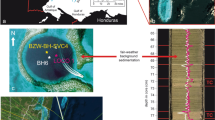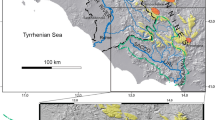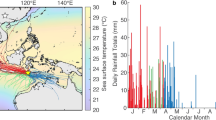Abstract
IT was recently shown1 that the occurrence of heavy rainfall (10 in. and above in 24 h) is related to lunar phase. It will be evident that such heavy falls are mostly associated with depressions, some of which intensify into cyclones and severe cyclones. A study was therefore undertaken to examine the dates of formation of depressions in the Indian Seas vis-à-vis the lunar phase. This communication was prompted by Bradley's article “Tidal Components in Hurricane Development”2 and is intended to provide some additional information to support his conclusions.
This is a preview of subscription content, access via your institution
Access options
Subscribe to this journal
Receive 51 print issues and online access
$199.00 per year
only $3.90 per issue
Buy this article
- Purchase on Springer Link
- Instant access to full article PDF
Prices may be subject to local taxes which are calculated during checkout
Similar content being viewed by others
References
Visvanathan, T. R., Ind. J. Meteorol. and Geophys.—Symp. “Hydrometeorology of India with Special Reference to Flood Forecasting and Warnings” (to be published).
Bradley, D. A., Nature, 204, 138 (1964).
Tracks of the Storms and Depressions in the Bay of Bengal and Arabian Sea (Indian Meteorological Department, 1964).
Carpenter, T. H., Decimal Ephemeris of the Sun and Moon (1870–1962) (U.S. Weather Bureau, Washington).
Author information
Authors and Affiliations
Rights and permissions
About this article
Cite this article
VISVANATHAN, T. Formation of Depressions in the Indian Seas and Lunar Phase. Nature 210, 406–407 (1966). https://doi.org/10.1038/210406a0
Issue Date:
DOI: https://doi.org/10.1038/210406a0
This article is cited by
-
Influence of Moon's long-period tide on rainfall in India
Il Nuovo Cimento C (1991)
Comments
By submitting a comment you agree to abide by our Terms and Community Guidelines. If you find something abusive or that does not comply with our terms or guidelines please flag it as inappropriate.



